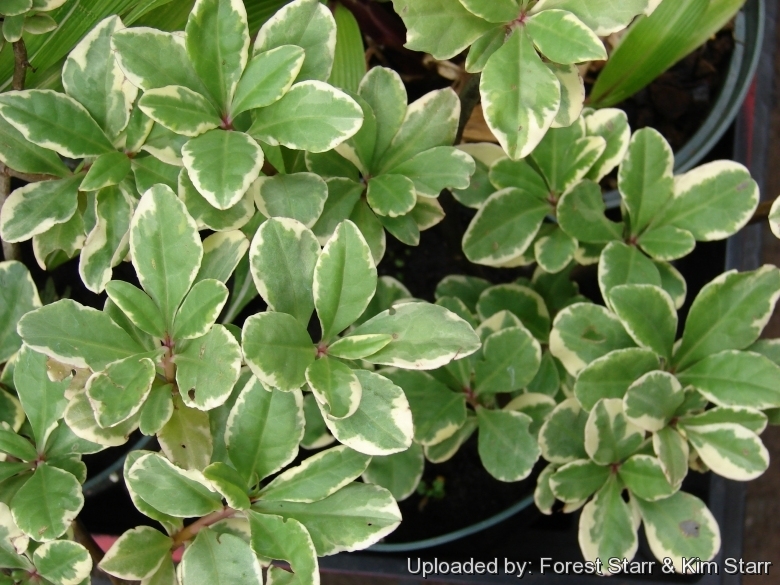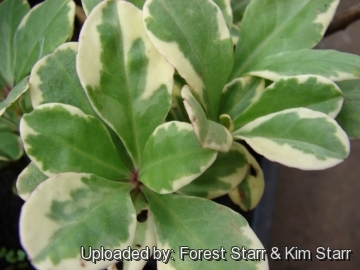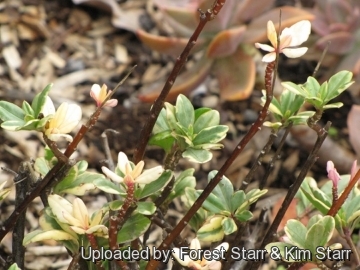
Talinum paniculatum cv. Variegatum Photo by: Forest Starr & Kim Starr
In pots at Kula Ace Hardware and Nursery, Maui, Hawaii (USA). September 06, 2007.
Origin and Habitat: Garden origin. Variegated cultivars.
Synonyms:
See all synonyms of Talinum paniculatum
back
Accepted name in llifle Database:Talinum paniculatum (Jacq.) Gaertn.Fruct. Sem. Pl. 2: 219 1791Synonymy: 20
Cultivars
(3):
back
Common Names include:
ENGLISH: Variegated Jewels of Opar, Fame Flower, Variegata Jewels of Opar, Jewels of Opar
Description: Talinum paniculaium is a fleshy, shrubby, erect, glabrous herbaceous plant, from the purslane family, that grows up to 100(-120) cm tall with perennial root-stock, not branched or sparsely branched at base, becoming softly woody below. This is probably the most widespread taxon of the genus, frequently encountered as weed. Its variability is enormous.
Variegated form: The variegate form of talinum (Talinum paniculatum variegata) has outstanding, reliable variegation that comes true from seed (but usually does not reseed
like the green form that drop seed everywhere and become a nuisance in the garden ). Leaves are a bright green with a white or creamy border. The blooms are starry pink with fluffy white stamens that sway on wiry stemmed sprays. The small, delicate pink flowers in cloudlike panicles make a nice contrast to the bright golden yellow, round seed capsules and are produced almost year-round. It is a good shade plant up to 90 cm tall.
Roots: Tuberous elongate branched and fleshy.
Stem: Succulent, slender, slightly woody at base, dark purple to brownish black.
Leaves: Alternate, simple, flat, succulent, bright green with a white or creamy border, almost sessile or with a pedicel to 15 mm long. Blade elliptical to obovate, 3-12 cm long, 1.5-4 cm wide, reduced abruptly beneath inflorescence. Base cuneate, apex obtuse or acute. Margin entire rarely revolute. Venation pinnate, indistinct. Stipules absent.
Inflorescence: A large, many-flowered terminal thyrsiform panicle, sometimes nodding, central axis 15?40(-60) cm long, laxly branched, the lateral dichasia spreading with very slender, stiff peduncles and pedicels bearing up to 30 flowers. Lateral branches sometimes contracted.
Flowers: Bisexual, regular, smallish, to 7 mm wide, opening towards evening. Pedicel 10-20 mm long, terete, uniformly slender. Sepals 2, green or pinkish to yellowish, ovate to suborbiculate, sometimes reflexed, deeply concave, 1.5-2 mm long to 2.5 mm wide, caducous. Petals 5, free, obovate to orbicular or emarginate, pink, 3-5 mm long. Stamens 15-18, Filaments almost completely free, hardly papillose basally. Ovary superior, globose, green, 1-celled, style c. 3 mm long, slender, with 3-branched linear stigma.
Fruits (capsules): Globose, sometimes obtusely trigonous, straw-yellow or amber-colored at first finishing off to a cinnamon red, 3-5 mm long, with 3 outer caducous and 3 inner membranous persistent but fragile valves elastically dehiscent from the base, many-seeded.
Phenology (Northern hemisphere): June-August (summer), September-November (fall). In the tropics flowers and capsules are produced almost year-round.
Seeds: Lenticular to comma-shaped, c. 1 mm long, shining black, smooth or tuberculate, elongated in concentric rings, minutely pitted at the cell corners. There are about 5000 seeds per gramme.
Chromosome number: 2n = 24
Subspecies, varieties, forms and cultivars of plants belonging to the Talinum paniculatum group
Bibliography: Major references and further lectures
1) Annuals : Talinum Variegated Summer Hill Seeds. <http://summerhillseeds.com> Web. 1 Dec. 2014.
2) Forest & Kim Starr Talinum paniculatum (Jewels of Opar). Plants of Hawaii. <http://www.starrenvironmental.com>. 23 Nov. 2014.
3) Urs Eggli Illustrated Handbook of Succulent Plants: Dicotyledons Springer Science & Business Media, 2002
4) Talinum paniculatum (Jacq.) Gaertn. [family PORTULACACEAE] in: Burkill, H.M. The useful plants of west tropical Africa Vol 4 1985.
5) Sylvia M. Phillips Flora of Tropical East Africa 2002
6) Robert W. Kiger Talinum paniculatum (Jacquin) Gaertner [family PORTULACACEAE] in: Flora of North America, Vol 4
7) Sajeva, Maurizio; Mariangela Costanzo Succulents: the Illustrated Dictionary. Timber Press. 1997
8) Hodgson, Larry Annuals for Every Purpose. Rodale. 2002
9) Winter, Norman, Limon talinum is jewel for gardens, Southern Gardening (Mississippi State University) Wednesday, 15-Sep-2010 URL: http://msucares.com/news/print/sgnews/sg07/sg070628.html
10) Wikipedia contributors. Talinum paniculatum. Wikipedia, The Free Encyclopedia. Wikipedia, The Free Encyclopedia, 24 Jul. 2014. Web. 1 Dec. 2014.
11) HANSEN, A. & P. SUNDING Flora of Macaronesia. Checklist of vascular plants. 4. revised edition. Sommerfeltia 17: [1-295] 1993
 Variegated leaves at Kula Ace Hardware and Nursery, Maui, Hawaii (USA). September 06, 2007. Photo by: Forest Starr & Kim Starr
Variegated leaves at Kula Ace Hardware and Nursery, Maui, Hawaii (USA). September 06, 2007. Photo by: Forest Starr & Kim Starr Habit at Kula Botanical Garden, Maui, Hawaii (USA). March 07, 2011. Photo by: Forest Starr & Kim Starr
Habit at Kula Botanical Garden, Maui, Hawaii (USA). March 07, 2011. Photo by: Forest Starr & Kim StarrCultivation and Propagation: Jewels-of-Opar Talinum paniulalum has attractive, succulent-looking foliage and is quick to send up arching panicles adorned with light to hot pink star-shaped flowers. Amazingly, these flowers appear repeatedly over a long period of time. It is a summer grower species that offers no cultivation difficulties. Good as a low accent plant in full sun or minimal shade areas. Can handle dry conditions as in rock gardens as it tolerates low moisture. It can be overwintered outdoors if sheltered from frosts.
Growth rate: Slow to moderate growth rate.
Soil: In cultivation it prefers well-drained, moist soil rich in organic matter, but it adapts to most soil types, preferably not too heavy in texture; good drainage is desirable.
Repotting: Repot in the spring, when their roots become cramped. Generally, they should be repotted every other year in order to provide fresh soil. After repotting, do not water for a week or more. Needs a large pot to accommodate a large root system.
Waterings: It is drought tolerant; A deep soaking once a month in the summer will keep the plant looking good. For pot culture in summer, during the vegetative period, it must be regularly watered, but allowing the substratum to completely dry up before irrigating again (but do not overwater); in winter, it












